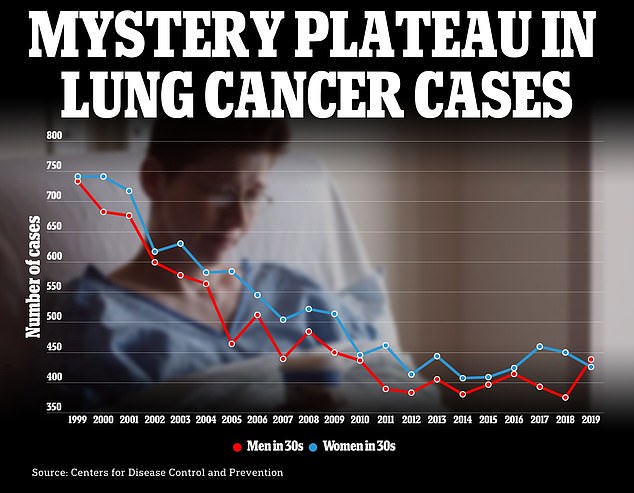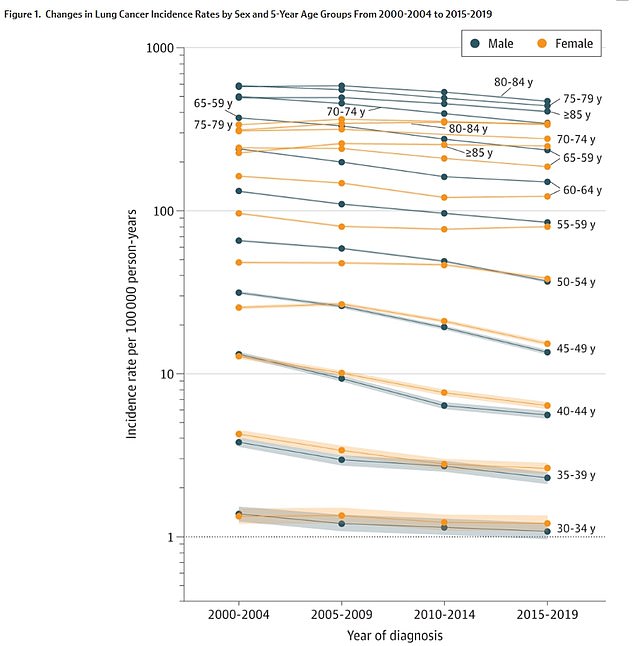As scientists work to unravel the mysterious rise in early-onset colon cancers, a worrying new trend has emerged.
Lung cancer rates, which have been declining for decades as the world quits smoking, are now rising in young, otherwise healthy people who have never smoked.
One in 10 lung cancer diagnoses in the U.S. is in patients younger than 55, but the rate of early cases has increased over the past two decades. And the proportion of these young patients who have never smoked cigarettes is also increasing.
Researchers believe the way new homes are built may be exposing residents to poisonous gas. They also say vaping and cannabis could be factors.
Matt Hiznay, who shared his story at ASCO, was diagnosed with stage four lung cancer in 2011. He was just 24 years old.

Researchers presenting at ASCO in Chicago said lung cancer is increasing among young Americans due to chemical exposure, vaping and genetic mutations, not just smoking.
Lung cancer is the deadliest form of the disease, accounting for one in five cancer deaths in the United States. In addition to more than 230,000 diagnoses, 125,000 Americans are expected to die from it this year.
Although most patients are over 70, Dr. Laura Mezquita, a medical oncologist in Spain, said during a panel at the world’s largest cancer research conference this weekend that there is an “increased incidence” in Americans under 50 years of age.
Beyond smoking, “we must consider other aspects,” he said.
Science has long established that smoking definitely causes lung cancer and is the leading risk factor for the disease.
However, although smokers make up up to 90 percent of older lung cancer patients, this number drops to 71 percent for younger patients.
Young patients also have significantly shorter exposures, averaging 11.5 years compared to 49 years for older patients.
“The shift away from the perception that smoking is fashionable is further decreasing the proportion of smokers among the young population,” the researchers wrote in a report released ahead of ASCO.
According to recent data from Pew Research, only 10 percent of young adults said they smoked between 2019 and 2023, compared to 35 percent between 2001 and 2003. This, the team suggested, indicates a near all-time low.
“Therefore, new evidence is emerging on exposure to group 1 carcinogens other than tobacco, where potency…degree of exposure…may play a larger role in younger patients.”

The above shows lung cancer cases among men and women divided by age groups. It reveals that the disease is now more common in younger women, compared to other groups.


Tiffany Job, 40, was diagnosed with stage four lung cancer after mistaking her symptoms for a pulled muscle. She had never smoked.
Group 1 carcinogens are substances that have been shown to cause cancer. Beyond smoking, others include air pollution and ultraviolet radiation.
“Radon gas is the leading cause of lung cancer among non-smokers and the second leading cause among smokers,” the researchers wrote.
Radon is an invisible, odorless gas produced from the decay of uranium in rocks, soil and water. The World Health Organization estimates that radon is responsible for three to 14 percent of lung cancers.
“Radon is the leading cause of cancer among non-smokers,” said Dr. Mezquita. “Radon is a risk factor also in young populations.”
He said this could be due to exposure to radon in homes from birth, which could enter the home through contaminated soil.
Additionally, a 2019 report in Nature found that radon exposure in homes is increasing because modern buildings are more airtight.
Dr. Mezquita also referred to vaping, which she noted “is very common in younger populations.”
Much of the science is unclear, but some recent reports have suggested that vaping may increase the risk of lung cancer, especially in those who have previously smoked.
A study, the first of its kind, conducted in Seoul, South Korea, analyzed health data from 4.3 million former smokers and found that those who switched to vaporizers were twice as likely to die from lung cancer, compared with those who quit smoking cold turkey.
Additionally, ASCO researchers noted that in youth who smoke, marijuana may exacerbate the risks.
‘Cannabis use often occurs alongside tobacco, posing challenges for separate assessment. “New evidence has linked it to more aggressive forms of lung cancer among young patients,” the team wrote.
Dr. Mezquita said that while there is evidence pointing to all of these factors, there is not just one to blame. ‘This is not just radon, it’s not just air pollution, it’s not just smoking. It is an interaction between all these risk factors.”
During ASCO, scientist and lung cancer survivor Dr. Matt Hiznay, 37, of Ohio, took the stage to detail how being diagnosed with lung cancer affected him as a young adult.
In 2011, Dr. Hiznay was diagnosed with stage four adenocarcinoma after several months of persistent cough and back and chest pain. He was only 24 years old and had never smoked.
“There really wasn’t any warning signs,” he said. “Cancer was nowhere on the radar.”
‘You are at the beginning of your life. When you are young and you are diagnosed, it is very difficult to see the future. Thoughts about the future are gone.
Although he never smoked and had no family history of lung cancer, Dr. Hiznay tested positive for a mutation of his EML4-ALK gene.
Former reports have shown that patients with EML4-ALK are “significantly” younger than patients with other mutations such as the more common EGFR. The median age of these patients was 52 years compared with 66 years in the control group.
Dr. Hiznay relapsed twice, but has been cancer-free since 2015. “As a 12-year survivor, I have made many friends in lung cancer survivor and I have survived them all, and that is something I carry with me.” ‘ he said.

